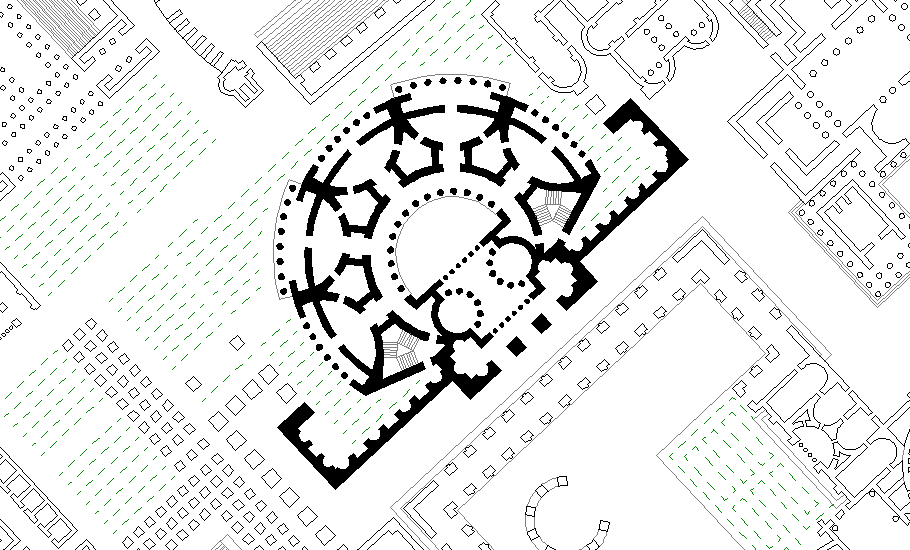The second bathing establishment in Rome, the thermae Neronianae, was built by Nero in 64 A.D., after the great fire. It was near the Pantheon and is spoken of as remarkable for its magnificence. For some unknown reason these baths were entirely rebuilt by Alexander Severus about 228 A.D., and were henceforth known only as the themae Alexandrinae. They occupied a rectangular area extending from the northwest corner of the Pantheon to the stadium of Domitian (piazza Navona), and although nothing remains above ground except a few portions of walls built into the palazzo Madama, excavations made at various times within this area have brought to light architectural fragments of great beauty and value. Among them are four columns of red granite, two of which were used in the restoration of the pronaos of the Pantheon; an enormous basin for a fountain, 6.70 meters in diameter, cut from a single block of red granite, with fragments of several others; white marble capitals; and fragments of columns of porphyry, pavonazetto, and gray granite.
(Platner)
Vincenzo Fasolo, "The Campo Marzio of G. B. Piranesi".
2691d
2691e
1956
| |
buildings of Alexander Severus
1998.09.21
The building projects of Alexander Severus as described within the The Scriptores Historiae Augustae.
...the Porticus Alexexandri Severi is in a totally incorrect position at the end of the Equiria, however, Piranesi may be making a suggestive link between Alexander Severus and the military. The small aedicule Isidis on the Equiria across from the Porticus may also be a reference to Alexander's devotion to his mother--Isis is the premiere mother goddess.
...the baths, aqueduct and his grove all comply correctly within the Ichnographia.
...the Domus (Palace of) Alexandri Severi is mentioned in the Historiae text, but it is not described, and my theory is that Piranesi placed Alexander's (house) Palace along the Triumphal Way (in the reverse mode) because he favored Christianity and the Golden Rule. The Domus Alexandri Severi is also exactly like the description of Elagabalus' Palace near the Porta Maggiore. Could Piranesi be weaving some complicated message which refers to both the reigns of Elagabalus and Alexander (which did follow each other, and they were cousins), where Alexander successfully undid the corruption of Elagabalus and began to turn Rome toward a more Christian and morally sound city and empire?
...not yet sure, but I think Alexander Severus' name is attached to more buildings within the Ichnographia second only to Nero.
| |
Alexander Severus
1998.12.01
a Roman emperor, A.D. 222-235.
Alexander Severus is one of four Roman emperors from the third century associated with buildings and specific sites delineated within the Ichnographia Campus Martius. Caracalla, Geta, and Gordian III are the other third century emperors named in the Ichnographia, however the number of building attributions apropos Alexander Severus substantially outnumber those of these emperors, and, Alexander Severus is indeed second only to the emperor Nero in the number of structures and places within the Ichnographia that bear his name. It is historically true that ample building activity in the Campus Martius occurred during Alexander Severus' reign, and, with one notable exception, Piranesi positions the Alexander Servian constructions with acceptable correctness within his large plan -- the placement of the Thermae Alexandri Severi, Nemus Alexandri Severi, and the Aqua Alexandrina (the Baths, Grove, and Aqueduct of Alexander Severus respectively) in the area west of the Thermae Agrippa and nearby the Thermae Neronianae coincides with corresponding verifiable archeological locations. Piranesi's positioning of the Porticus Alexandri Severi, on the other hand, at the end of the Equiria, far to the north of the Campus Martius, deviates grossly from its traditional location near the Saepta Julia.
The only questionable building that Piranesi attributes to Alexander Severus within the Ichnographia, which may or may not have actually been within the Campus Martius, is the Domus Alexandri Severi.
|
